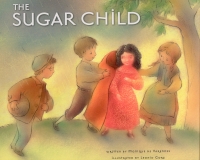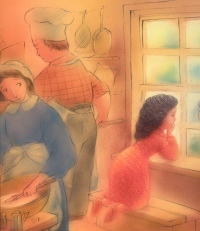| ________________
CM . . .
. Volume XI Number 15 . . . .April 1, 2005
excerpt:
Monique de Varennes, an American author, has drawn on her French-Canadian heritage in this rich, warm-hearted story of a childless baker and his wife who weave a protective world around the "sugar child" Jacques creates out of marzipan. To their astonishment, the child comes to life overnight, but her life is as fragile as the thin sugar skin that melts with each tear the child sheds. Their sugar daughter is named Matine "from the French word for morning, for that was when she had come into their lives." At first, the bakers keep Matine from playing with other children, fearful of the sun, rain, or Matine's own tears melting her. Matine's yearning to play with the other children makes her parents cast aside their fears, and they allow her to venture outside. Matine's playmates take over, protecting her by "guiding her into the shade when the sun grew hot and wrapping her in their own hoods and scarves at the first drop of rain." Matine develops a special friendship with Jean-Paul, a little boy with a lung condition that, like Matine, prevents him from playing outside in the rain. When the boy becomes seriously ill, Matine's parents, fearful of her tears, tell her that Jean-Paul has gone on vacation. Matine sees through the good intentions of her parents and begs the truth. She rushes to her sick friend's bedside and, on seeing him so ill, begins to cry. The tears melt her "sugar" skin and reveal the "warm flesh of a real child."
Complementing this lovely tale are the soft muted acrylic paintings of Leonid Gore. The illustrations are tinged with ochre, green and violet; the ochre reflecting warmth, the violet emphasizing winter's dark loneliness, while the greens of spring and summer promise rebirth. Mr. Gore also gives his characters sensitive countenances, particularly the wistful looks on Matine's face as she watches children playing outside and the concern Therese shows as her daughter discovers Jean-Paul's illness. Using pointillism when illustrating Matine gives her a sugary appearance in contrast to the smoothly washed supporting characters. The Sugar Child is an exceptional book, and its French-Canadian heritage makes it a delightful addition to any collection of folk and fairy tales. Highly Recommended. Barbara Taylor is an Early Childhood teacher and freelance writer.
To comment
on this title or this review, send mail to cm@umanitoba.ca.
Copyright © the Manitoba Library Association. Reproduction for personal
use is permitted only if this copyright notice is maintained. Any
other reproduction is prohibited without permission.
NEXT REVIEW |
TABLE OF CONTENTS FOR THIS ISSUE
- April 1, 2005.
AUTHORS |
TITLES |
MEDIA REVIEWS |
PROFILES |
BACK ISSUES |
SEARCH |
CMARCHIVE |
HOME |

 This is a gently told story that complements the familiar tales of Pinocchio and The Gingerbread Boy. Not only does it include the magical touches of a child made of sugar becoming flesh; it also deals, as a fairy tale should, with the overcoming of obstacles and fears. Matine leaves her protected world and risks her existence to be with her friend. The story ends happily for Matine, but there is a sense of incompleteness with the character of Jean-Paul. As Matine's tears fall on him, his complexion takes on a healthy glow, but he is subsequently described as reaching "a weak hand toward her." As this is the last mention of Jean-Paul, the reader is left wondering about his fate. Perhaps this is intentional, giving Jean-Paul a more realistic prognosis, but it takes away from the "happily ever after" aspect one expects of a fairy tale.
This is a gently told story that complements the familiar tales of Pinocchio and The Gingerbread Boy. Not only does it include the magical touches of a child made of sugar becoming flesh; it also deals, as a fairy tale should, with the overcoming of obstacles and fears. Matine leaves her protected world and risks her existence to be with her friend. The story ends happily for Matine, but there is a sense of incompleteness with the character of Jean-Paul. As Matine's tears fall on him, his complexion takes on a healthy glow, but he is subsequently described as reaching "a weak hand toward her." As this is the last mention of Jean-Paul, the reader is left wondering about his fate. Perhaps this is intentional, giving Jean-Paul a more realistic prognosis, but it takes away from the "happily ever after" aspect one expects of a fairy tale.